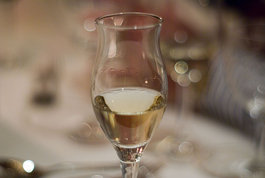Grappa
Grappa is a fragrant grape-based pomace brandy of between 37.5% and 60% alcohol by volume (75 to 120 proof), of Italian origin. Literally "grape stalk", most grappa is made by distilling pomace, grape residue (mainly the skins, but also stems and seeds) left over from winemaking after pressing. It was originally made to prevent waste by using leftovers at the end of the wine season. It quickly became commercialised, mass-produced, and sold worldwide. Some grappa, known as prima uva, is made with the whole grapes. The flavour of grappa, like that of wine, depends on the type and quality of the grape used as well as the specifics of the distillation process.
Grappa was originally made in the northern Italian town of Bassano del Grappa, and some contend that this is the origin of the name, rather than from the Latin graspa.
In Italy, grappa is primarily served as a "digestivo" or after-dinner drink. Its main purpose was to aid in the digestion of heavy meals. Grappa may also be added to espresso coffee to create a caffè corretto meaning corrected coffee. Another variation of this is the "ammazza caffè" (literally, "coffee-killer"): the espresso is drunk first, followed by a few ounces of grappa served in its own glass. In the Veneto, there is resentin: after finishing a cup of espresso with sugar, a few drops of grappa are poured into the nearly empty cup and swirled, and drunk down in one sip.
Among the most well-known producers of grappa are Nonino, Berta, Sibona, Nardini, Jacopo Poli, Brotto, Domenis and Bepi Tosolini. While these grappas are produced in significant quantities and exported, there are many thousands of smaller local and regional grappas, all with distinct character.
Most grappa is clear, indicating that it is an un-aged distillate, though some may retain very faint pigments from their original fruit pomace. Lately, aged grappas have become more common, and these take on a yellow, or red-brown hue from the barrels in which they are stored.
Tasting
The method which thoroughly tried and tested by professional tasters, who distinguish the following four categories of grappa:
- young grappas
- cask-conditioned grappas
- aromatic grappas
- aromatized grappas
Grappa tastings invariably begin with "young grappas" and then continue with cask-conditioned and aromatic grappas before finishing with aromatized grappas.
When the tasting involves more than one grappa from the same category, the examination begins with the grappa that has the lowest alcohol content and concludes with the product richest in alcohol. In the case of the two grappas with the same alcohol content, the tasting begins with the smoother and less markedly flavoured product, which the organizer of the tasting will have selected beforehand.
After each tasting and before sampling another glass, it is recommended that tasters drink half a glass of fresh, pasteurized milk, swirling the liquid around the mouth thoroughly, in order to refresh the taste receptors on the tongue.
Another way to "taste" grappa is by rubbing a small amount on the back of the hand and sniffing. If the aroma is pleasant, the grappa is well made. Impurities in grappa come out in the vapor and can be easily distinguished in this way.
Various other food products can help to prevent the taste characteristics of one grappa being "dragged over" from one tasting to "contaminate" the subsequent grappa. Some of the items that perform this task, and which also provide an agreeable accompaniment to grappa's own flavour, are:
- salted pistachio nuts
- rusks spread with acacia-blossom honey and topped with a flake of mature Montasio or Parmiggiano-Reggiano cheese.
(Source: Lessons on Discriminating Drinking/Distilleria Domenis)
Glass
With the introduction of "boutique grappas" elaborate flute glasses have been promoted; traditionalists continue to taste grappa in the simple shot glass.
References
- Giardino, Maresciallo, Il fuoco del grappa e la documentazione austriaca, Quaderni di storia della guerra, 1928
- Behrendt, Axel, Grappa: A Guide to the Best, 2000
Further reading
- Ove Boudin, Grappa: Italy Bottled (Wine Appreciation Guild 2008)
- Axel Behrendt, et al., Grappa: A Guide to the Best (Abbeville Publishing Group (Abbeville Press, Inc.) 2000)
